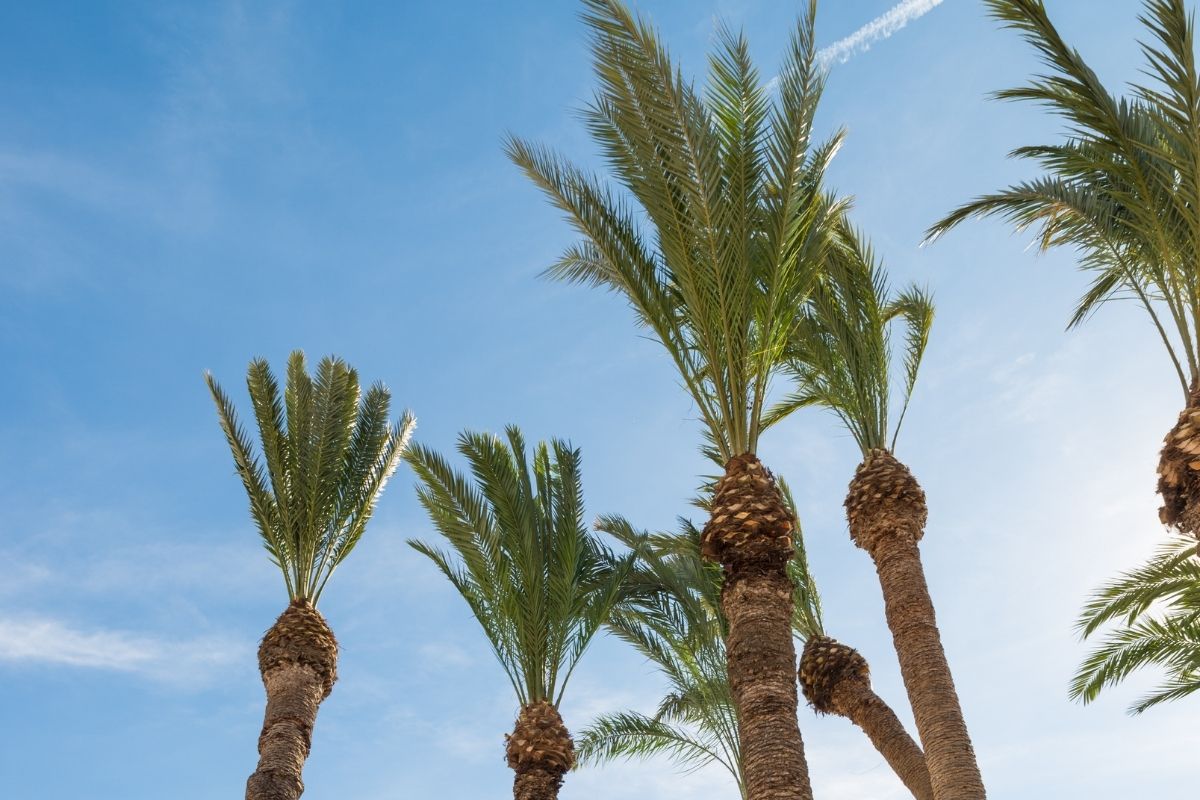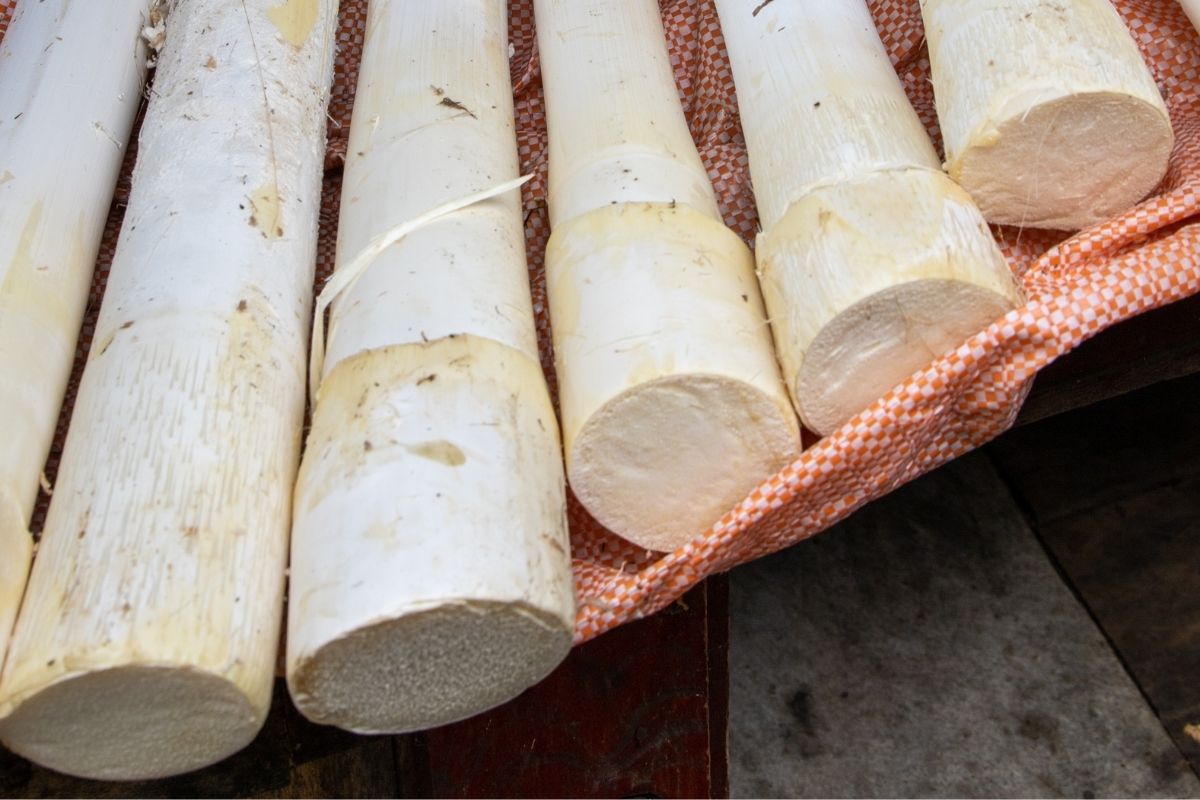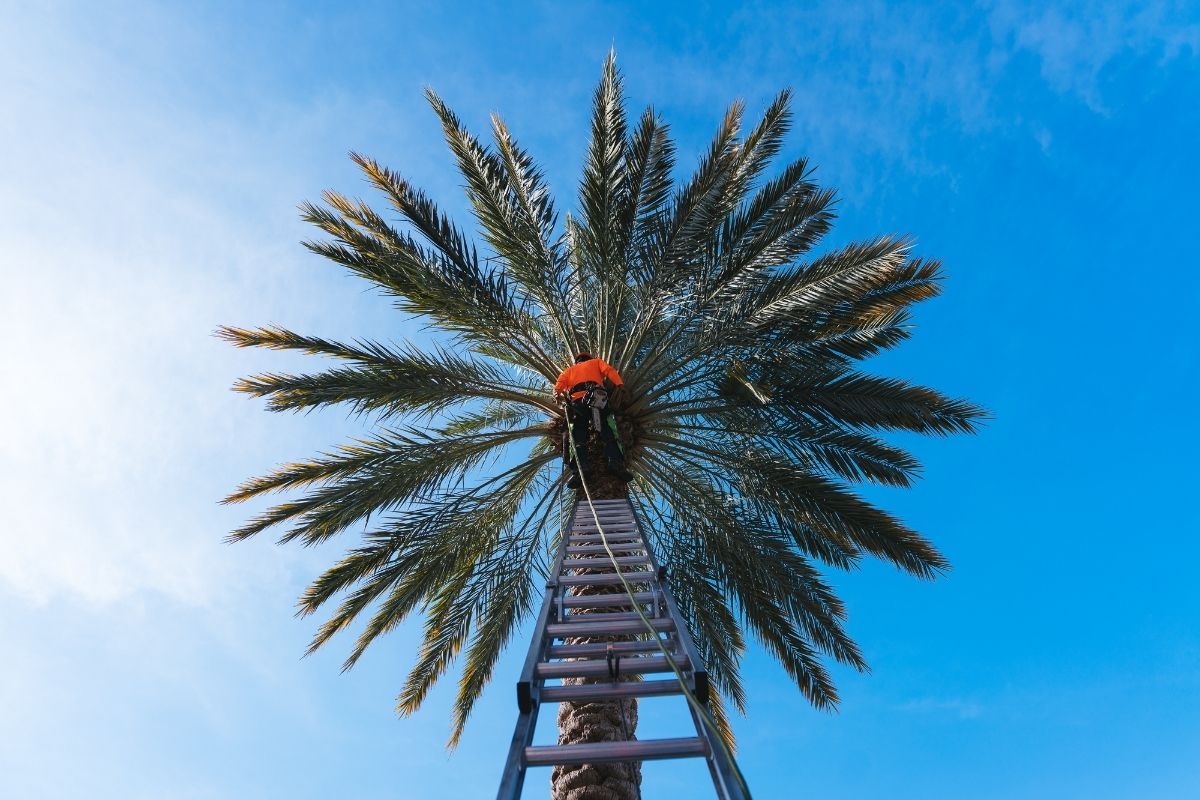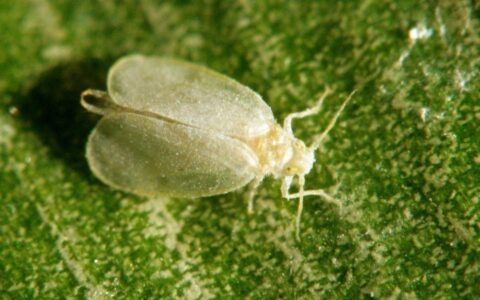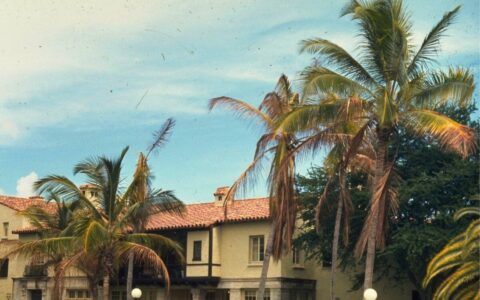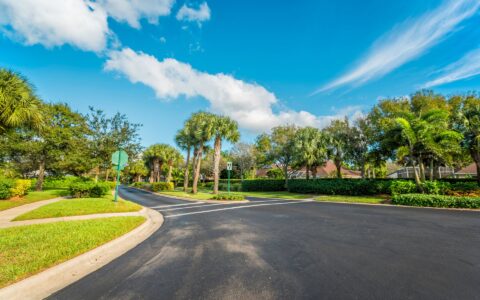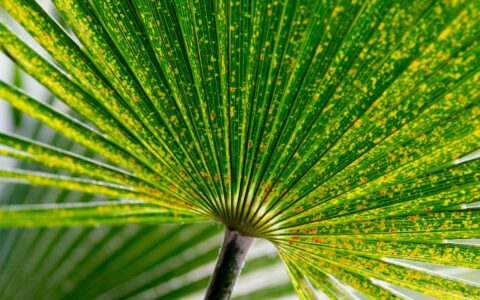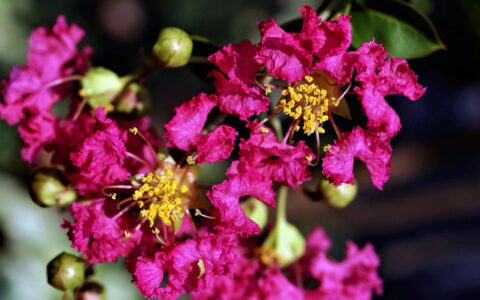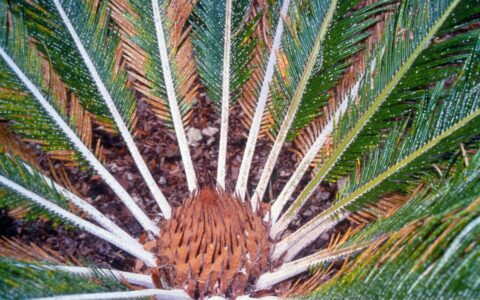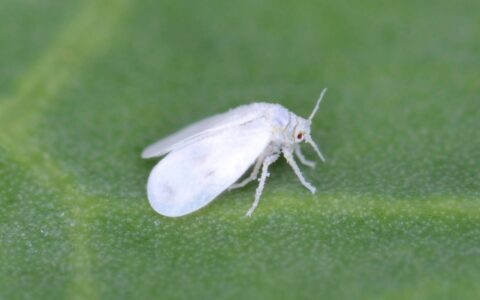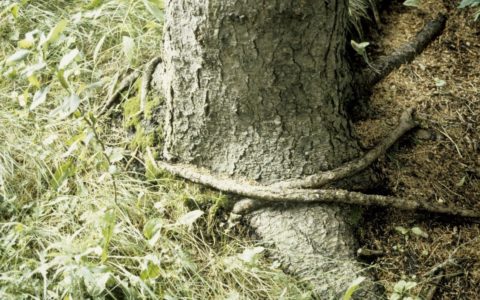Palms are a common sight in South Florida, which is why we’ve devoted articles to how to plant palms, how to prune palms, several palm diseases, and more.
Just like any other plant, however, palms can suffer from pests, diseases, and environmental issues. Knowing how to spot these issues and what to do about them can mean the difference between healthy palms and unsightly, dying palms that need to be removed.
In this article, we cover some of the most common palm issues we encounter here in South Florida. We’ll also give you some information on what (if anything) you can do for your palms to prevent or treat these issues.
Read on to learn more!
Common Palm Issues in South Florida
Ganoderma Palm Disease
If a white circular mass shows up on the bottom 5 feet of your palm trunk, it’s probably the rot fungus called Ganoderma. It is caused by Ganoderma zonatum, which can affect any palm. The disease is sometimes referred to as Ganoderma butt rot since it affects the bottom part of the palm. The white conk will eventually darken in color and the palm branches will wilt. Eventually, the palm fronds change color and the palm’s growth rate slows.
Diagnosing Ganoderma can be difficult until the conks appear, but it usually affects palms that are 15 years old or older. If your palm does have Ganoderma, the recommended action is to remove the tree.
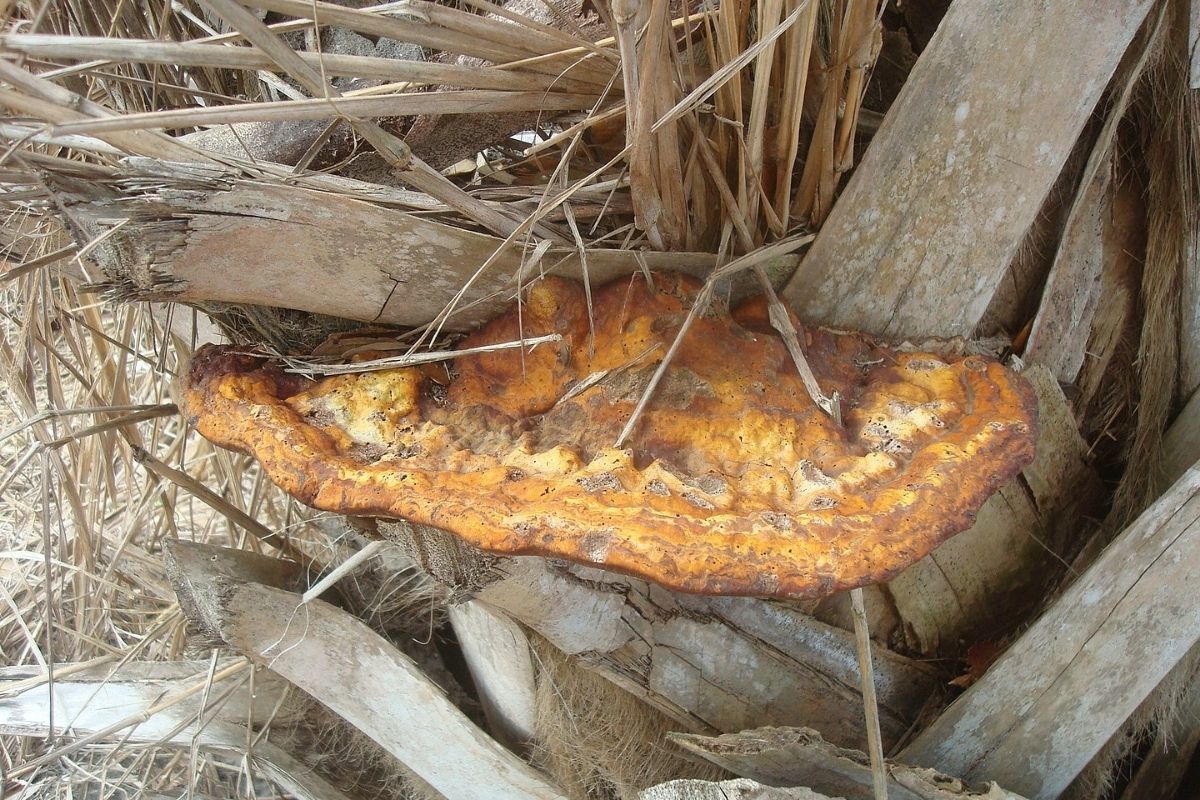
A Ganderma conk on a Sabal Palm in Florida. By MycoMyco UnDay – Own work, CC BY-SA 3.0, https://commons.wikimedia.org/w/index.php?curid=29438040
Palm Tree Fusarium Wilt
Palms infected with palm tree Fusarium wilt will show signs of underwatering, including wilting fronds and discolored leaves that eventually turn brown. This doesn’t mean that the palm is not being watered enough, rather it is due to the Fusarium wilt. Spores of the fungus enter the plant through the roots and affect the xylem, which reduces the amount of water that the palm can take up.
While Fusarium wilt is a disease that can impact a variety of shrubs and ornamental trees, palm tree Fusarium wilt looks slightly different. This disease is also caused by a fungus, Fusarium oxysporum, and will kill trees faster in dry areas than in humid ones. It is also contagious to other palms, so it’s usually best to remove any infected palms before the disease spreads. Keep in mind, however, that the fungus that causes Fusarium wilt can remain in the soil for several years. If you are replacing an infected palm, you should plant something that won’t be impacted by this fungus.
Another way that Fusarium wilt can spread is through unsanitized pruning tools. If a diseased plant is pruned with a lopper, for example, and then that same lopper is used on a healthy plant or palm without being sanitized, the spores can spread from one plant or palm to another.
While there is no cure for Fusarium wilt, it can be successfully managed. Dying fronds can be pruned away but be sure to keep them away from healthy plants and don’t put the fronds in your compost. Keep your palms well-watered and consider fertilization to help the palm get more nutrients.
Lethal Bronzing & Lethal Yellowing
Older palms with dead flowers and dropped fruit or young palms with progressively dying leaves may be suffering from lethal bronzing or lethal yellowing.
Both lethal bronzing and lethal yellowing in palms are caused by bacteria that are often spread by leafhoppers and planthoppers.
As the names imply, there is no cure for these diseases. You can learn more in our FAQs article about lethal bronzing and lethal yellowing.
Over Pruning
Yes, this is a palm issue! And it can be a pretty disastrous one. Over-pruning palms can cause narrowing of the trunk which can lead to long-term issues. Eventually, it can reduce the longevity of your palm.
How can pruning too much harm a palm? Well, the same way it can impact trees. Trees and palms use photosynthesis to survive, and they need leaves for that process. If too many palm fronds are removed at once, you are destroying the palm’s food source. In addition, when many fronds are pruned off at the same time, the palm tries to use stored energy to replace those fronds.
If palms are severely over-pruned, they lose the fronds that protect the terminal bud (the point from which all new fronds grow), increasing the risk of damage to the bud that can kill the whole palm. Some of the lower fronds also serve as a support for the upper ones, protecting them from high winds and colder temperatures.
Learn how to avoid over-pruning your palms and the proper method here >>
Overwatering
The South Florida climate is perfect for supporting a wide range of landscape plants, shrubs, trees, and palm. And that’s both a blessing and a curse. Why? Because many people place plants with very different water needs next to each other or on the same irrigation zone.
With both native and introduced palm species found throughout South Florida, there are some large differences in water needs; some prefer more arid conditions while others grow best with additional moisture. But when the two are planted together and watered the same way, one is going to suffer. We see many dead palms that have simply been overwatered, resulting in fungal problems and rotting roots.
Cutting the Heart out of Palms
You may have heart of “heart of palm” as a food item to buy for a recipe, but do you know where to find it in your palms?
Unlike trees, which have their most important part underground, palms have their most important part in the middle – the heart. It is aptly named, because once it is removed, the palm dies. It is the soft tissue found in the middle of the tree. Palms don’t have rings like wood-based trees, but they do have layers of leaves that make up the trunk. When those layers are removed, you can reach the heart. It is white in color and has a softer texture.
If you’re curious about what “heart of palm” looks like or how it is harvested, check out this video showing a palm grower in Hawaii that ships the heart of palm all over the country for use in restaurants.
Remember, cutting the heart out of your palm will kill it, and not all varieties of palm tree hearts are edible.
Weevils
The Sabal palm, Florida’s state tree, is a beautiful palm with a hidden weakness. It’s susceptible to attack by a large weevil (Rynchophorus cruetatus) that eats the bud of the palm and whose offspring burrow into the heart of the palm after hatching. The bud is the point from which all new fronds grow; if it’s damaged or destroyed, the top of the palm will die. If you’ve ever seen dead palms where it looks like the top has fallen over, it’s likely been killed by weevils.
These weevils are especially attracted to stressed palm trees (such as from improper irrigation, lack of nutrients, over pruning, or disease), as well as to Sabal, Washingtonia, and Canary Island Date palms.
You may not notice signs of weevil infestation until it’s too late. But if you suspect something is wrong, or if you’re doing some palm trimming, look at the cut end of one of the fronds you’ve removed. If you see a large hole, it’s time to call the arborists at Sherlock Tree to spray your palm trees for weevils.
Discolored or Spotted Leaves
Leaf spots can be caused by bacterial and fungal diseases, environmental conditions, and insect pests. Left untreated, many of these can cause serious damage. Because there are so many potential causes, it’s helpful to have your palm inspected by an arborist to help diagnose the issue and recommend an appropriate treatment.
For example, Graphiola leaf spot or false smut is a fungal disease that causes dark round spots with grayish-black fuzz, particularly on the lower leaves of date palms. It can be treated with manganese-based fungicides.
But those treatments won’t help with spots caused by sap-sucking insects like aphids, spider mites, and whiteflies. These insects can also cause black patches to form on fronds, trunks, or beneath palms. Known as sooty mold, this fungal disease grows on the honeydew (a sugary substance) excreted by sap-sucking insects. Insect infestations are usually treated with a high-powered spray (to reach the top of taller palms) or a systemic insecticide injected or sprayed onto the trunk.
Cracked Trunks
We’ve sometimes been called to examine a palm tree whose trunk suddenly developed a large vertical crack. It’s usually nothing too serious but, rather, an indication that the palm isn’t receiving proper care. Split trunks often happen because the palm has gotten too little or too much water, or because it was planted too deep. In most cases, the palm will be fine if you treat it properly. If it’s a really deep crack, we might recommend a preventive fungicide treatment.
To prevent this, make sure you’re providing the right amount of moisture for your palms.
Nutrient Deficiencies
Like any other plant, palms need enough nutrients to support their continued growth and keep them healthy. The key is to understand which nutrients specific palms need and how best to provide it.
Without the right nutrients, such as nitrogen, potassium, magnesium, iron, and zinc, new palm fronds get smaller, and existing ones yellow or develop a scorched or frizzled look. For example, “frizzle top” is caused by a lack of manganese and is most commonly seen in Queen, Cycad, Paurotis, and Royal palms. Over time, nutrient deficiencies cause palms to slowly decline and eventually die.
Thankfully, this problem is relatively easy to correct – provided you know which nutrient(s) is/are lacking. A professional soil test or an experienced arborist can tell you if anything is out of balance and recommend how to remedy the situation.
Other Palm Issues You May Notice
Each palm is unique, as are the locations where they are planted. There are plenty of other diseases and pests that may plague your palms; this list of palm diseases from the University of Florida may be a good place to start your research, or you can schedule a property consultation with the professionals at Sherlock Tree.
Some palm issues you may encounter are not disease-related but can still cause problems, such as:
- Dead fronds
- Pests that roost in palms (such as rodents or swarms of bees)
- Messy fruit from palms
- And more
Scheduling a consultation with one of our tree care professionals allows us to view the palms in question and to give you advice on how to proceed.
How to Prevent or Treat Palm Issues
As with any tree or plant, preventing an issue before it can occur is preferable. Keeping your palms healthy includes regular maintenance by a professional as well as ensuring that your palms receive enough water and nutrients.
Fertilization, spray treatments, and other preventive measures may be possible, depending on the type of palm and issues it is prone to. Learn more about how to keep your palms healthy on our Tree Health Solutions page.
If your palms have been assessed by an arborist and are suffering from a pest or disease issue, treatment options may be possible. Your plant health care technician at Sherlock Tree will let you know your options.
When a palm is beyond treatment or repair, removal may be the only option for some diseased palms.
We Can Help Your Palms
If any of the symptoms described above sound like one or more of your palms, or if you are noticing any other issues, give us a call. We’ve been caring for South Florida palms for over 40 years and we will gladly care for yours too. We have experience working with all the palm species in South Florida and have proven ways to test and treat your palms for a wide range of pests and diseases. If treatment isn’t possible, we can quickly and safely remove any palm.
Call Sherlock for quality tree services
Whether you're looking for specific tree care services, such as palm trimming, tree removal, or disease treatments, or would like one of our Arborists to examine your trees to identify any issues and recommend options, we're always here for you! Just give us a call at 954-788-4000 to set up an appointment.
SEE MORE ARTICLES
Looking for more?
We've got you covered with a monthly newsletter full of tips, resources, updates, how-to's, and other helpful information about trees and landscapes in South Florida!

